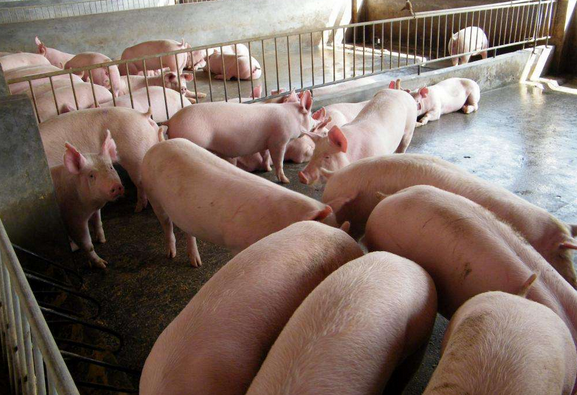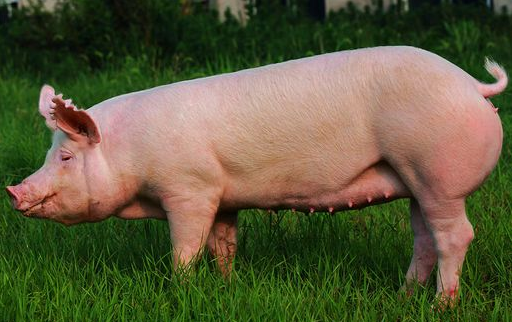Treatment of porcine calcium and phosphorus metabolic disorders with integrated traditional Chinese and Western medicine
Calcium and phosphorus metabolism disorders occur in young pigs, resulting in bone malnutrition called rickets. The pathological features are insufficient calcification of osteoblasts, persistent calcification of persistent cartilage hypertrophy and osteophyte enlargement. The clinical features are digestive disorders, heterophilic habits, lameness and skeletal deformation. It is a non-inflammatory disease of bone tissue dysplasia, and vitamin D deficiency also plays an important role in the pathogenesis of rickets. Calcium and phosphorus metabolic disorders occur in adult pigs, resulting in bone dystrophy called rickets, or fibrous osteodystrophy. The pathological feature is progressive decalcification of the bone, showing osteoporosis and formation of an excess of uncalcified bone matrix, or chondrocyte fibrous tissue hyperplasia, increased bone mass and reduced weight. The clinical features are digestive disorders, heterophilic, lameness, osteoporosis and bone deformation. It is caused by the lack of calcium or phosphorus in the feed and the imbalance between the two. The disease is common in piglets, growing pigs with poor management, and sows during lactation and short weaning.
1, the cause
1.1 The feed is not properly matched. Long-term feeding of a single feed, especially in the rural part of the pigs for a long time with simple corn, wheat bran or rice bran as a concentrate; and some brewing pig farmers, long-term simple distiller's grains for the diet. In this way, due to the imbalance of calcium and phosphorus in the feed (the ratio of calcium to phosphorus is higher or lower than 1:0.8, the optimum ratio of calcium to phosphorus in the feed is 1:0.8), most of which is calcium deficiency, plus vitamins. The lack or deficiency of D leads to the occurrence of rickets or rickets and fibrous bone dystrophy. In particular, piglets are very sensitive to the lack of vitamin D, coupled with the imbalance or lack of calcium and phosphorus, leading to rickets in piglets.
1.2 Long-term feeding management is poor. Pigs sleep on wet ground for a long time, long-term hunger and satiety, long-term thirst drink too much cold water, overeating frozen feed, lack of exercise, resulting in weak spleen and stomach, digestion and malabsorption, even if there is a proper proportion of calcium and phosphorus in the feed, Incomplete absorption leads to imbalance or lack of calcium and phosphorus in the body. Pigs do not deworm for a long time, so that the parasites in the intestines are particularly numerous, causing damage to the intestinal mucosa, causing intestinal inflammation and incomplete absorption of nutrients, and absorption of trace elements such as calcium and phosphorus is also reduced.
2, symptoms
Early appearance of loss of appetite, indigestion, lack of energy, followed by heterophile, such as eating wood ring plate, if the pig pen is made of concrete, the pigs will eat the soil on the wall; more often, After eating the feces; then, the pigs appear limp, the movement is not working, the hindquarters sway when walking (some cases have limb rims), the arch back standing or lying down, the appetite is reduced, the heavy can eat or not Eat, the body is getting thinner. After a while, due to insufficient calcification of the systemic bone matrix or progressive decalcification of the systemic bone, joint enlargement, swelling, pain, abnormal shape, "0" leg or "eight" leg, waist The back plate is hard, the skull is deformed, the maxilla and the nasal bone are swollen and bulged, and the hard E is prominent, causing the lips to sag, the oral closure difficult, and the maxillary bones to be swollen and thickened. In the elderly, the teeth are worn, the chewing is slow, and the mouth is flowing. In some cases, the ear, nose and nose are cold, the feces are thin and even diarrhea, and the urine is short. This is the yang deficiency type osteomalosis which is known by the Chinese veterinarians. In some cases, the ear and nose are warm, the fecal ball is dry, and the urine is dark yellow. For the Chinese veterinary school, the yin deficiency type of osteoarthritis; in some cases, the course of disease is longer, the body is thin, the skull is deformed, the nose is swollen, the joints of the extremities are swollen and deformed, the claudication is obvious, often lying down, standing up difficult, urinary clear The mouth color is pale, this is the yin and yang deficiency type of osteoporosis.

3, diagnosis
According to feeding and management conditions, feed mix, growth retardation, heterophilic phlegm, joint swelling of the extremities, and changes in teeth and bones (more sows in late pregnancy and lactation), it is not difficult to make a diagnosis.
4, treatment
4.1 Western medicine treatment
4.1.1 Appropriate proportion of calcium, phosphorus and vitamins in the diet. If you add appropriate amount of bone meal or calcium hydrogen phosphate or vitamin AD3 powder in the feed. At the same time, adding appropriate amounts of trace elements such as copper, iron, zinc, manganese and cobalt to the feed can improve the curative effect and shorten the course of treatment.
4.1.2 If the symptoms are serious, another intravenous injection of calcium gluconate injection, Weiding gelatinous calcium injection, vitamin B: injection, mixed intramuscular injection, once every 2 days. Piglets can also be given intramuscularly with iron dextran or dextran iron injection at a dose of 200 mg per piglet, once every 6 days until cured.
4.2 Chinese medicine treatment Because Chinese medicine believes that the disease is spleen, stomach, kidney weak, so the principle of treatment is mainly spleen and stomach and kidney, supplemented by Huoxue Tongjing.
4.2.1 Yang deficiency type, treated with Yizhi San. Namely: Yizhiren 30g, nutmeg 25g, woody 10g, Schisandra 20g, betel nut 10g, grass fruit 25g, asarum 10g, green skin 25g, Atractylodes 30g, peony 30g, white peony 5g, clam shell 25g, licorice 15g, large Jujube 30g, ginger 10g, a total of the end, 1 day 1 dose, and even served 5 doses.
4.2.2 Yin deficiency type, treated with addition and subtraction of tiger diving pills. Namely: Zhimu 30g, rehmannia 30g, turtle shell 60g, white peony 25g, dried tangerine peel 25g, Cynomorium 20g, Achyranthes 20g, bone broken 15g, Codonopsis 30g, Atractylodes 20g, Clam shell 25g, Magnolia 25g, total end, 1 dose per day, and even take 5 to 7 doses.
4.2.3 yin and yang deficiency type, with the addition and subtraction of Yidihuang powder treatment. Namely: Yizhiren 30g, Schisandra 30g, Angelica 30g, Rehmannia 30g, Cinnamon 25g, Hawthorn Meat 25g, Yam 25g, Codonopsis 25g, Atractylodes 25g, Danpi 20g, Buguzhi 20g, Licorice 15g, total end, each 1 day, even 5 to 7 doses.
In clinical practice, 678 pigs were treated for calcium and phosphorus metabolism disorders, 248 cases were treated with western medicine alone, 238 cases were cured, the cure rate was 96%, the average course of treatment was 28 days; 430 cases were treated with combination of Chinese and Western medicine, and the cure rate was 100. %, the average course of treatment is 15 days.
5, discussion
5.1, pigs due to lack of calcium in the diet, or excessive phosphorus and relative calcium deficiency, resulting in the body's calcium and phosphorus metabolism disorders, a series of clinical appetite loss, indigestion, and then heterophile, limp It is getting thinner, the joints of the extremities are enlarged, swollen, abnormal shape, deformed of the skull, swelling of the upper jawbone, frontal bone, nasal bones, swelling of the mandible, and other clinical conditions. The Chinese veterinary school calls this a weak spleen and stomach. Western medicine treatment is to add an appropriate proportion of calcium, phosphorus, vitamin D in the feed, or simultaneous injection of calcium preparations, vitamin D preparations, which can only have a good effect on cases with particularly mild clinical symptoms: more prominent clinical symptoms Cases, due to the long course of disease, the pig's appetite decreased, indigestion, less feed intake, resulting in other nutrients, making the body's spleen, stomach, kidney weak, or even systemic failure, while calcium, phosphorus, vitamins D can not treat the weakness of the spleen, stomach and kidney of the body, as well as systemic failure. Only with the spleen and kidney, and the traditional Chinese medicine prescription supplemented by Huoxue Tongjing can correct the weakness of the spleen, stomach and kidney, as well as systemic failure, so that the body returns to normal.

5.2, due to the body's spleen, stomach, kidney weakness, and systemic failure, is caused by calcium, phosphorus deficiency, mainly calcium deficiency, vitamin D deficiency caused by the cause. Therefore, in the clinical treatment of calcium and phosphorus metabolism disorders, it is essential to increase the proper proportion of calcium and phosphorus in the feed, mainly calcium and vitamin D, or to simultaneously inject calcium preparations and vitamin D preparations; The main purpose of tonifying the kidney and supplementing the blood circulation and passing through the traditional Chinese medicine prescription is that the body can not be less, and the combination of Chinese and Western treatment shortens the course of treatment and improves the cure rate.
5.3. The combination of traditional Chinese and western medicine for the treatment of porcine calcium and phosphorus metabolism disorders is superior to western medicine alone, and can be actively applied in clinical practice.
The above is the combination of traditional Chinese and Western medicine for the treatment of porcine calcium and phosphorus metabolic disorders, for your reference, and hope to help you. Huinong School has more relevant agricultural technology knowledge. Continue to pay attention to Huinong School to answer questions during planting or breeding.
Amino acid additives are used in feed to balance or supplement a particular production purpose of the required nutrients. The main amino acids added in the feed are: lysine, tryptophan, methionine, threonine these limiting amino acids. Amino acids are the basic building blocks of proteins. The essence of protein nutrition is amino acid nutrition. The core of amino acid nutrition is the balance between amino acids.
The balance of amino acids in natural feed is very poor. Almost all of them are not balanced. The animal body in the limited feed can not synthesize themselves.
They can only rely on eating intake of amino acids. The amino acid content of natural feed is very different, each is not the same, because of different kinds, different ratio of natural feed composed of full price compound feed, although try to mix according to the principle of amino acid balance, but their various amino acid content and the proportion between amino acid is still variable, various. Therefore, amino acid additives are needed to balance or supplement the requirements for a particular production purpose.
feed amino acides Lysine,feed amino acides Tryptophan,high quality Threonine
Allied Extracts Solutions , https://www.alliedadditives.com